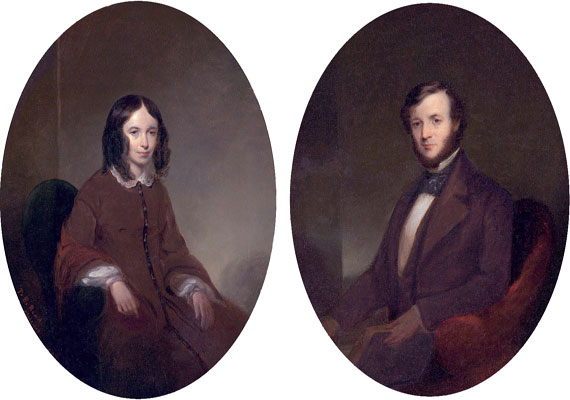“A Sea-Side Walk” by Elizabeth Barrett Browning contains beautiful imagery coupled with elements of melancholy and angst. From the start, Browning introduces an undertone of negativity: “We walked beside the sea,/After a day which perished silently” (ln 1-2). Her word choice is significant because she is expressing that it was a day the quietly died as opposed to any normal day. The wording conjures up an image of suffering in silence. This leads the reader to assume that perhaps Browning is referring to her own feelings. There are many possible explanations that could account for this sentiment. The most obvious reason would be her controlling father. Another explanation could be the difficulties placed on her simply by being a female writer at the time. Unlike some of her contemporary female authors, Browning did not believe in hiding the fact that she was a woman. She was also dealing with the deaths of her mother and brother, as well as her own ailing health at that time.
She goes on to reference “The Story of the Envious Man” from Arabian Nights.
Of its own glory—like the Princess weird
Who, combating with the Genius, scorched and seared,
Uttered with burning breath, “Ho, victory!”
And sank adown, an heap of ashes pale; (ln 3-6)
In this story, a Sultan’s daughter uses her intelligence and power to turn an enemy (Genius) into a “heap of ashes” in order to save a prince and turn him back into a man. She cries out “victory!” but ultimately ends up just as unfortunate as the genius despite her redeeming qualities.
Stanza II personifies the “cliffs” as having the power and control:
On which, the cliffs permit us to see
Only the outline of their majesty,
As master-minds, when gazed at by the crowd!
And, shining with a gloom , the water grey (ln 10-13)
The cliffs are allowing the crowd to see what they want the crowd to see, which is the gloom of the grey water. This personification of control brings to mind Browning’s difficult childhood; more specifically, her strained relationship with her father or society’s difficulty accepting female writers. The use of “master-minds” seems to support this claim.Perhaps Browning feels that her father and/or society, being represented by the cliffs, controls what society is permitted to see of her. She has so much talent and passion that she wants to share but she is being restricted. Similarly, Stanza III places the sun in a dominant position over the moon and the stars: “They did not dare to tread so soon about,/Though trembling, in the footsteps of the sun.” (ln16-17) The time of day is beautifully described but tainted with personified elements of fear. The use of “did not dare” and “trembling” signify a strong sense of apprehension. Throughout the poem, there is an unease that accompanies every alluring subject. Stanza IV places “man” against “nature” yet ends with a bit of positivity. Browning personifies nature as having a ”solemn-beating heart” that is “Bound unto man’s by cords he cannot sever-“ (ln 24). The idea that hearts are bound together typically signifies love. The publication of this poem was before she began her love affair with Robert Browning. Since it has been well-documented that the love the Browning’s had for each other was pure and true, it can be assumed that that the strained relationship with her father, or perhaps society, is being referenced here.
And, what time they are slackened by him ever,
So to attest his own supernal part,
Still runneth thy vibrations fast and strong,
The slackened cord along. (ln 25-28)
There is a glimmer of hope seeping through this passage. Although there are only small, slight chances of the cord being slackened, nature and therefore Browning herself, still continue to show what beauty they can manage no matter how much or little the cord is being pulled. They may not ever fully be free of their restraints, but they still continue to shine when they can. Hope is never totally lost.
There is a pattern of describing something beautiful and even majestic-like and then personifying it as being scared or restricted in some way. A kinship is formed between the speaker and the sea as they seem to come to an understanding with each other. “And, had we seen each other’s face,we had/Seen haply, each was sad.” (ln 34-35). In “A Sea-Side Walk”, nature reflects the sadness, angst and restraint of the speaker. At the same time, nature also demonstrates the beauty, potential and hope of the speaker. Browning is projecting her mood upon the sea. On the surface, this poem is simply a beautiful work of imagery. However, the constant undertones of fear and angst personify the work to a different level. Suddenly, why the speaker was walking by the sea and what happened to prompt that walk become questions of great significance.
Some online learning platforms provide certifications, while others are designed to simply grow your skills in your personal and professional life. Including Masterclass and Coursera, here are our recommendations for the best online learning platforms you can sign up for today.
The 7 Best Online Learning Platforms of 2022
- Best Overall: Coursera
- Best for Niche Topics: Udemy
- Best for Creative Fields: Skillshare
- Best for Celebrity Lessons: MasterClass
- Best for STEM: EdX
- Best for Career Building: Udacity
- Best for Data Learning: Pluralsight















